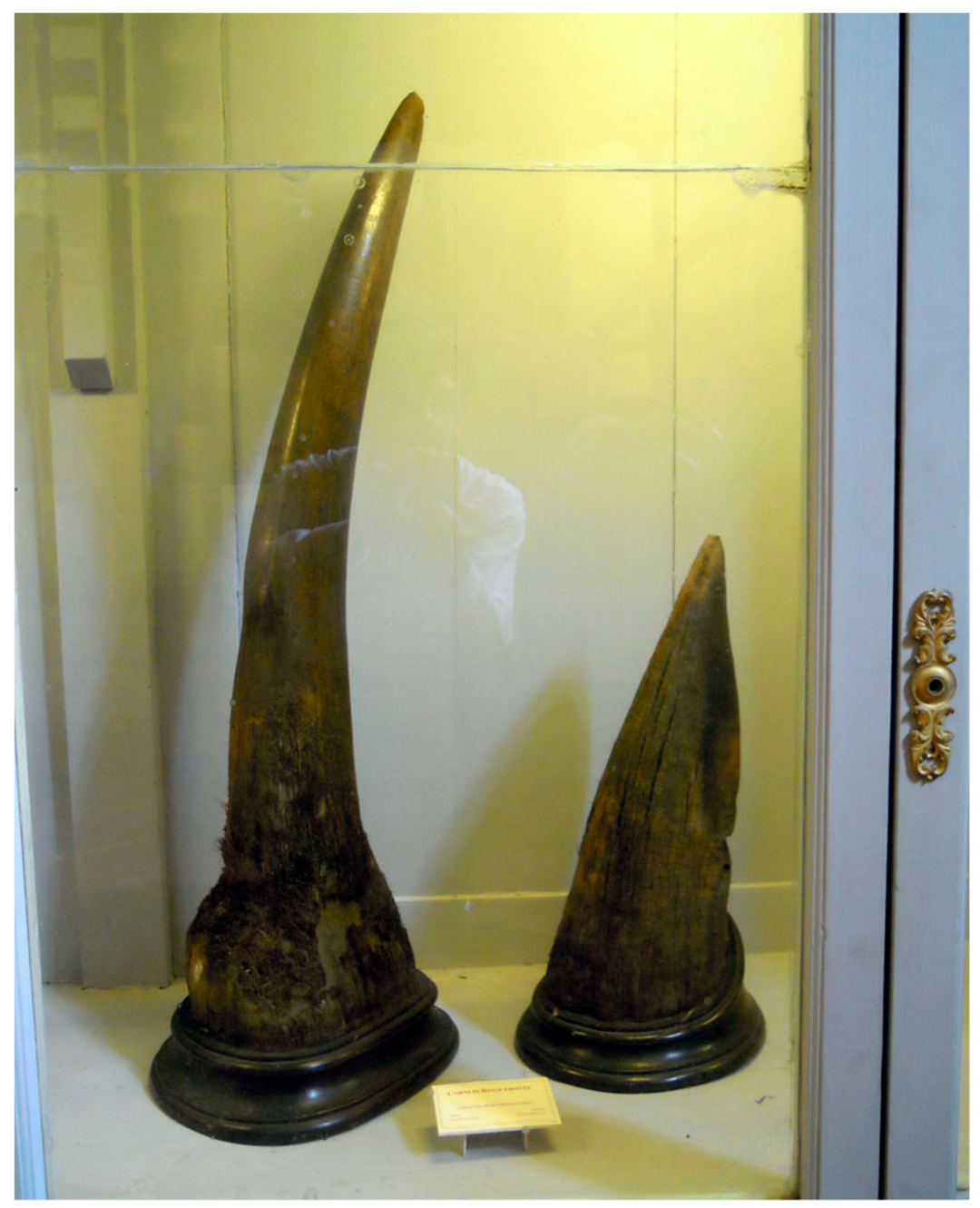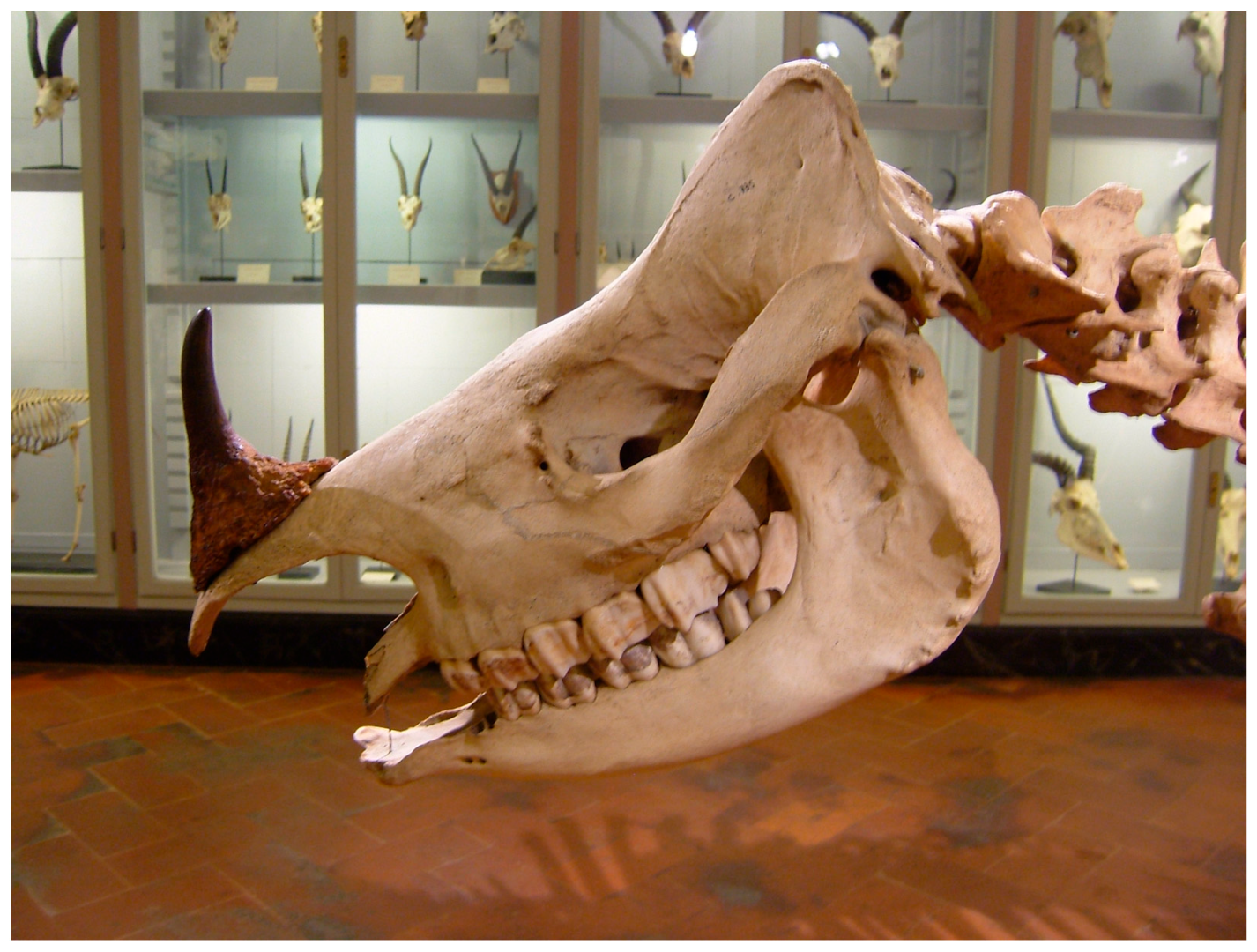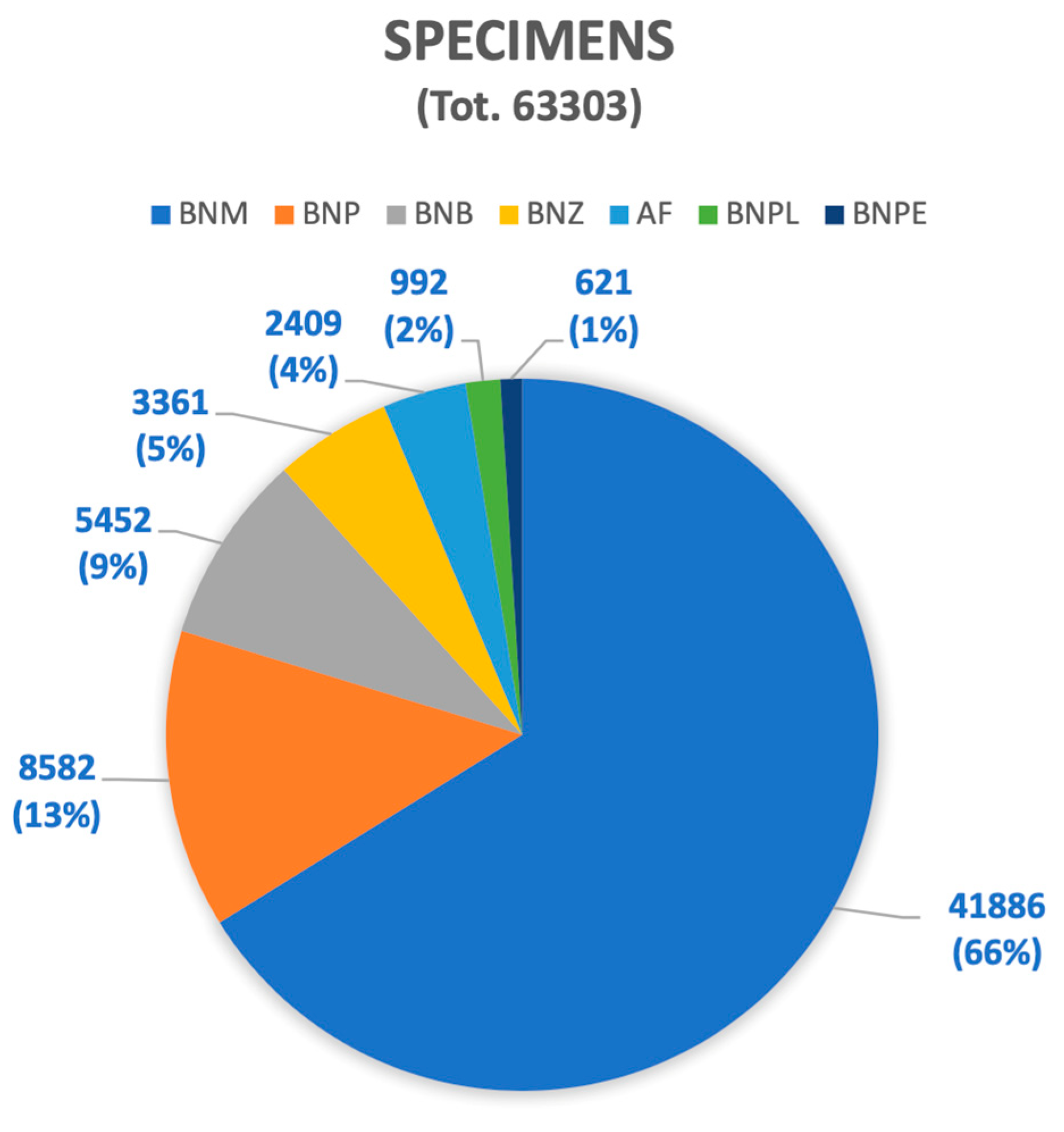Knowing Is Better than Wondering: The Cataloging of Natural Heritage between Museum Studies and Crime
Abstract
1. Introduction
2. Materials and Methods
3. Results
4. Discussion
5. Conclusions
Author Contributions
Funding
Institutional Review Board Statement
Informed Consent Statement
Data Availability Statement
Acknowledgments
Conflicts of Interest
References
- Regener, S. Criminological museums and the visualization of evil. Crime Hist. Soc. 2003, 7, 43–56. [Google Scholar] [CrossRef]
- Carrabine, E. The Tuol Sleng Museum of Genocidal Crimes: Phnom Penh, Cambodia. In 50 Dark Destinations: Crime and Contemporary Tourism; Lynes, A., Craig, K., Treadwell, J., Eds.; Bristol University Press: Bristol, UK, 2023; pp. 107–115. [Google Scholar]
- Hammond, L. The Alcatraz East Crime Museum: Pigeon Forge, Tennessee, USA. In 50 Dark Destinations: Crime and Contemporary Tourism; Lynes, A., Craig, K., Treadwell, J., Eds.; Bristol University Press: Bristol, UK, 2023; pp. 41–49. [Google Scholar]
- Montaldo, S. The Lombroso Museum from its origins to the present day. In The Cesare Lombroso Handbook; Knepper, P., Ystehede, P., Eds.; Routledge: New York, NY, USA, 2013; pp. 98–112. [Google Scholar]
- Bianucci, P.; Cilli, C.; Giacobini, G.; Malerba, G.; Montaldo, S. Cesare Lombroso Museum of Criminal Anthropology, University of Turin; Hapax: Turin, Italy, 2011. [Google Scholar]
- Cilli, C.; Malerba, G.; Giacobini, G.; Montaldo, S. Il video “Torino 1911: Le promesse della scienza” del Museo di Antropologia criminale “Cesare Lombroso”. Un esempio di progetto condiviso. Museol. Sci. Mem. 2016, 15, 68–71. [Google Scholar]
- Mangiapane, G.; Spanu, L.; Cilli, C.; Malerba, G.; Giacobini, G. I visitatori del Museo di Antropologia criminale “Cesare Lombroso” dell’Università di Torino. Un primo bilancio dopo un anno di apertura al pubblico. Museol. Sci. 2011, 5, 146–155. [Google Scholar]
- Benzaquen, S. Looking at the Tuol Sleng Museum of Genocidal Crimes, Cambodia, on Flickr and YouTube. Media Cult. Soc. 2014, 36, 790–809. [Google Scholar] [CrossRef]
- Spanu, L.; Cilli, C.; Malerba, G. Far parlare oggetti di collezioni storiche. Esempi dal Museo Lombroso di Torino. Museol. Scienifica Mem. 2014, 11, 37–41. [Google Scholar]
- Isaac, R.K.; Çakmak, E. Understanding the motivations and emotions of visitors at Tuol Sleng Genocide Prison Museum (S-21) in Phnom Penh, Cambodia. Int. J. Tour. Cities 2016, 2, 232–247. [Google Scholar] [CrossRef]
- Light, D. Progress in dark tourism and thanatourism research: An uneasy relationship with heritage tourism. Tour. Manag. 2017, 61, 275–301. [Google Scholar] [CrossRef]
- Ciliberti, R.; Monza, F.; De Stefano, F.; Licata, M. The trial of the skull studied by the founder of Criminal Anthropology: The war of the Lombroso Museum. J. Forensic Leg. Med. 2018, 59, 13–15. [Google Scholar] [CrossRef] [PubMed]
- Carlos, A.F.; Poloni, T.E.; Medici, V.; Chikhladze, M.; Guaita, A.; Ceroni, M. From brain collections to modern brain banks: A historical perspective. Alzheimer’s Dement: Transl. Res. Clin. Interv. 2019, 5, 52–60. [Google Scholar] [CrossRef]
- Knackmuhs, E.; Farmer, J.; Knapp, D. Addressing contemporary criminal justice issues as interpretive outcomes at a prison museum. Visit. Stud. 2020, 24, 1–16. [Google Scholar] [CrossRef]
- Motena, M.S. Museums as Dark Tourism Destinations: The Kgoši Mampuru Correctional Service Prison Museum. SAMAB 2022, 44, 38–46. [Google Scholar]
- Williams, T. Remembering and silencing complexity in post-genocide memorialisation: Cambodia’s Tuol Sleng Genocide Museum. Mem. Stud. 2022, 15, 3–19. [Google Scholar] [CrossRef]
- Biber, K. Evidence in the museum. Curating a miscarriage of justice. Theor. Criminol. 2017, 22, 505–522. [Google Scholar] [CrossRef]
- Stamatopoulou, E.; Argyropoulos, V.; Panagiaris, G.; Papadakos, N.; Christodoulou, P.; Koutselinis, A. Low-budget collection management at the Criminal Museum, School of Forensic Medicine, University of Athens. Museologia 2003, 3, 95–100. [Google Scholar]
- Thurston, H. Museum ethnography: Researching punishment museums as environments of narrativity. Methodol. Innov. 2017, 10, 2059799117720615. [Google Scholar] [CrossRef]
- Yun, S. Curiosity, wonder and museum education. J. Philos. Educ. 2018, 52, 465–482. [Google Scholar] [CrossRef]
- Walby, K.; Piché, J.; Friesen, B. “… they didn’t just do it because it was a job”: Representing wardens in Canadian penal history museums. Int. J. Law Crime Justice 2018, 53, 1–8. [Google Scholar] [CrossRef]
- Walby, K.; Piché, J.; Ferguson, M. “Everybody criticizes police, but nobody criticizes museums”: Police Headquarters and Museums as Public Culture. TOPIA 2021, 43, 81–99. [Google Scholar] [CrossRef]
- Pauls, H.; Walby, K.; Piché, J. Regimes of representation in Canadian police museums: Othering, police subjectivities, and gunscapes. Crime Media Cult. 2023, 19, 114–134. [Google Scholar] [CrossRef]
- Arford, T.; Madfis, E. Whitewashing criminology: A critical tour of Cesare Lombroso’s Museum of Criminal Anthropology. Crit. Criminol. 2022, 30, 723–740. [Google Scholar] [CrossRef]
- Giacobini, G.; Cilli, C.; Malerba, G. Il riallestimento del Museo di Antropologia criminale “Cesare Lombroso” dell’Università di Torino. Patrimonio in beni culturali e strumento di educazione museale. Museol. Sci. 2010, 4, 137–147. [Google Scholar]
- Garlandini, A.; Montaldo, S. The Lombroso Museum in Turin: A reflection on the exhibition and scientific study of human remains. In Museums, Ethics and Cultural Heritage; Murphy, B.L., Ed.; Routledge: New York, NY, USA, 2016; pp. 341–349. [Google Scholar]
- Sakki, Z.; Athanaselis, S.; Spiliopoulou, C.; Stefanidou, M. The Values and Meanings of a Crime Collection. Int. J. Incl. Mus. 2015, 8, 1–14. [Google Scholar] [CrossRef]
- Elek, L. Analysis of the crime scene model using three objects from the Hans Gross Museum of Criminology collection of the University of Graz. Arch. Kriminol. 2016, 239, 181–192. [Google Scholar]
- Biedermann, B. ‘Virtual museums’ as digital collection complexes. A museological perspective using the example of Hans-Gross-Kriminalmuseum. Mus. Manag. Curatorship 2017, 32, 281–297. [Google Scholar] [CrossRef]
- Biedermann, B. The Potentials of the Digital Cultural Heritage: A Best Practice Example of Presentation and Use. The Digital Representation of the Hans Gross Kriminalmuseum. In Digital Cultural Heritage; Kremers, H., Ed.; Springer: Cham, Switzerland, 2020; pp. 195–207. [Google Scholar]
- Pratesi, G.; Vannozzi, F. (Eds.) I Valori del Museo. Politiche di Indirizzo e Strategie di Gestione; FrancoAngeli: Milano, Italy, 2014. [Google Scholar]
- Brodie, N.; Proulx, B.B. Museum malpractice as corporate crime? The case of the J. Paul Getty Museum. J. Crime Justice 2014, 37, 399–421. [Google Scholar] [CrossRef]
- Cox, S.P. White collar crime in museums. Curator 2017, 60, 235–248. [Google Scholar] [CrossRef]
- Ganciu, I. Heritage for Sale! The Role of Museums in Promoting Metal Detecting and Looting in Romania. Heritage 2018, 1, 437–452. [Google Scholar] [CrossRef]
- Atkinson, C.; Yates, D.; Brooke, N. ‘Now that you mention it, museums probably are a target’: Museums, terrorism, and security in the United Kingdom. Mus. Manag. Curatorship 2020, 35, 109–124. [Google Scholar] [CrossRef]
- Bessette, A. Vandalism in Art Museums: Case studies from 1985 to 2013. J. Art Crime 2016, 15, 15. [Google Scholar]
- Hufnagel, S.; Chappell, D. (Eds.) The Palgrave Handbook on Art Crime; Palgrave Macmillan: London, UK, 2019. [Google Scholar]
- Runhovde, S.R. Perspectives on Police Specialization in Art Theft Investigations. Policing 2021, 15, 1729–1743. [Google Scholar] [CrossRef]
- Burmon, K.M. Challenges to study: Difficulties arising in studying fine art theft. In Global Perspectives on Cultural Property Crime; Fabiani, M.D., Burmon, K.M., Hufnagel, S., Eds.; Routledge: London, UK, 2023; pp. 160–174. [Google Scholar]
- Brisman, A. Vandalizing meaning, stealing memory: Artistic, cultural, and theoretical implications of crime in galleries and museums. Crit. Criminol. 2011, 19, 15–28. [Google Scholar] [CrossRef]
- Runhovde, S.R. Risking Munch. The art of balancing accessibility and security in museums. J. Risk Res. 2021, 24, 1113–1126. [Google Scholar] [CrossRef]
- Runhovde, S.R. In the dark, all art dealers are grey: Discretion and rationalisation in the Munch art market. Int. J. Crime Justice Soc. Democr. 2021, 10, 1–14. [Google Scholar] [CrossRef]
- Levy, M.P. Works of art and ivory: What are the issues? Curator 2018, 61, 47–60. [Google Scholar] [CrossRef]
- Good, C.; Tyrrell, P.; Zhou, Z.; Macdonald, D.W. Elephants never forget; should art museums remember too? Historic ivory collections as ambassadors for conservation education. Biodivers. Conserv. 2019, 28, 1331–1342. [Google Scholar] [CrossRef]
- Dorfman, E.J. Elephants and ivory: Coordinating natural history museum action to address wildlife crime. Curator 2018, 61, 133–145. [Google Scholar] [CrossRef]
- Zhao, Y.; Xu, L.; Xiao, Y.; Guan, J.; Lau, W. Revisiting China’s Ivory Markets in 2017; Traffic: Cambridge, UK, 2017; pp. 1–21. [Google Scholar]
- Still, J. Use of animal products in traditional Chinese medicine: Environmental impact and health hazards. Complement Ther. Med. 2003, 11, 118–122. [Google Scholar] [CrossRef]
- Truong, V.D.; Dang, N.V.; Hall, C.M. The marketplace management of illegal elixirs: Illicit consumption of rhino horn. Consum. Mark. Cult. 2016, 19, 353–369. [Google Scholar] [CrossRef]
- Thomas-Walters, L.; Hinsley, A.; Bergin, D.; Burgess, G.; Doughty, H.; Eppel, S.; MacFarlane, D.; Meijer, W.; Lee, T.M.; Phelps, J.; et al. Motivations for the use and consumption of wildlife products. Conserv. Biol. 2021, 35, 483–491. [Google Scholar] [CrossRef]
- Biggs, D.; Cooney, R.; Roe, D.; Dublin, H.; Allan, J.R.; Challender, D.W.; Skinner, D. Developing a theory of change for a community-based response to illegal wildlife trade. Conserv. Biol. 2017, 31, 5–12. [Google Scholar] [CrossRef]
- Gibbs, C.; Gore, M.L.; McGarrell, E.F.; Rivers, L., III. Introducing conservation criminology: Towards interdisciplinary scholarship on environmental crimes and risks. Brit. J. Criminol. 2010, 50, 124–144. [Google Scholar] [CrossRef]
- South, N.; Beirne, P. Green Criminology; Routledge: London, UK; New York, NY, USA, 2017. [Google Scholar]
- Vigne, L. The Rhino Horn and Ivory Trade, 1980–2020. Ph.D. Thesis, Oxford Brookes University, Oxford, UK, 2020. [Google Scholar]
- Viscardi, P. The Horns of a Dilemma: The Impact of the Illicit Trade in Rhino Horn; NatSCA News: Woking, UK, 2012; pp. 8–13. [Google Scholar]
- Teixeira, C.; Waterhouse, D.M.; Moura, L.; Andrade, P. Displaying a taxidermy rhinoceros in a museum: The Lisbon conservation approach. Conserv. Patrim. 2020, 33, 10–23. [Google Scholar] [CrossRef]
- Donovan, C.T. Rhinos and the Illegal Horn Trade Top CITES Agenda. Nat. Resour. Environ. 2014, 29, 51–53. [Google Scholar]
- Rhino Horn Stolen from Michael Flatley Home in Cork. Available online: https://www.bbc.com/news/uk-northern-ireland-25924136 (accessed on 13 July 2023).
- Watford Man Advertised Rhino Horns on Instagram. Available online: https://www.bbc.com/news/uk-england-beds-bucks-herts-41943387 (accessed on 13 July 2023).
- Rhino Horn Thieves Use Stun Gas in Paris Museum Raid. Available online: https://www.bbc.com/news/world-europe-16067019 (accessed on 13 July 2023).
- Grove, L.; Thomas, S. ‘The rhino horn on display has been replaced by a replica’: Museum security in Finland and England. J. Conserv. Mus. Stud. 2016, 14, 1–11. [Google Scholar]
- Rhino Horn Raiders Steal Replicas from Tring Museum. Available online: https://www.bbc.com/news/uk-england-beds-bucks-herts-14693144 (accessed on 13 July 2023).
- Dicks, K.L. Developmental Validation of a Forensic Profiling System for Black Rhinoceros (Diceros bicornis) and Extraction of Nuclear DNA from Historic Rhinoceros Horns. Master’s Thesis, University of Chester, Chester, UK, 2014. [Google Scholar]
- Ewart, K.M.; Frankham, G.J.; McEwing, R.; Webster, L.M.I.; Clavaglia, S.A.; Linacre, A.M.T.; Dang, T.T.; Ovouthan, K.; Johnson, R.N. An internationally standardized species identification test for use on suspected seized rhinoceros horn in the illegal wildlife trade. Forensic Sci. Int. Genet. 2018, 32, 33–39. [Google Scholar] [CrossRef]
- Rhino Horn Robbers Stopped by Norwich Castle Museum Staff. Available online: https://www.bbc.com/news/uk-england-norfolk-17112582 (accessed on 13 July 2023).
- Irish Rhino Horn Racket Uncovered by Europol. Available online: https://www.bbc.com/news/world-europe-14066052 (accessed on 13 July 2023).
- Crowe, S.; Cresswell, K.; Robertson, A.; Huby, G.; Avery, A.; Sheikh, A. The case study approach. BMC Med. Res. Methodol. 2011, 11, 100. [Google Scholar] [CrossRef] [PubMed]
- Furto Alla Specola, Rubati 3 Corni di Rinoceronte. Available online: https://www.lanazione.it/firenze/cronaca/2011/06/09/521427-spariti_corni.shtml (accessed on 13 July 2023).
- Di Nomaglio, G.N. Vittorio Emanuele Conte di Torino. Riv. Coll. Arald. 2022, 109, 49–72. [Google Scholar]
- Per un Pugno di Cheratina. Available online: https://www.cicap.org/n/articolo.php?id=274894 (accessed on 13 July 2023).
- Furto al Museo di Storia Naturale: Rubati due Corni di Rinoceronte. Available online: https://www.ilrestodelcarlino.it/macerata/cronaca/furto-corno-rinoceronte-museo-naturale-1.87849 (accessed on 13 July 2023).
- Corno di Rinoceronte Rubato all’Ateneo di Modena: Il Giallo dell’hard Disk. Available online: https://www.gazzettadimodena.it/modena/cronaca/2015/06/12/news/corno-rubato-il-giallo-dell-hard-disk-1.11596780 (accessed on 13 July 2023).
- Furto al Museo di Storia Naturale di Calci: Rubato Corno Afrodisiaco. Available online: https://www.lanazione.it/pisa/cronaca/calci-furto-corno-afrodisiaco-1.742259 (accessed on 13 July 2023).
- Veggetti, A.; Maestrini, N. L’insegnamento della Medicina Veterinaria nell’Università di Bologna: (1783/84-2000); Bononia University Press: Bologna, Italy, 2004. [Google Scholar]
- Rubati dal Museo un Corno di Rinoceronte e un Dente di Narvalo. Available online: https://www.ilrestodelcarlino.it/bologna/cronaca/furto-museo-corno-rinoceronte-dente-narvalo-1.1024405# (accessed on 13 July 2023).
- Rubano Corni di Rinoceronte al Museo di Storia Naturale, ma Sono Copie. Available online: https://liguriaoggi.it/2015/08/09/rubano-corni-di-rinoceronte-al-museo-di-storia-naturale-ma-sono-copie/ (accessed on 13 July 2023).
- Museo Zoologico Rubati Cinque Corni di Rinoceronte. Available online: https://napoli.repubblica.it/cronaca/2015/09/11/foto/museo_zoologico_rubati_cinque_corni_di_rinoceronte-122658168/1/ (accessed on 13 July 2023).
- Baker, B.; Jacobs, R.; Mann, M.; Espinoza, E.; Grein, G. (Eds.) CITES Identification Guide for Ivory and Ivory Substitutes; World Wildlife Fund Inc.: Washington, DC, USA, 2020. [Google Scholar]
- Accused Narwhal Ivory Smuggler Detained in U.S. Available online: https://www.nationalgeographic.com/animals/article/160320-wildlife-trafficking-crime-blotter (accessed on 13 July 2023).
- Il Corno Violato. Il Rinoceronte tra Estinzione e Superstizione. Available online: http://www.anms.it/eventi/dettaglio_evento/1317 (accessed on 13 July 2023).
- Ebrahimi, S. Art Theft: The Isabella Stewart Gardner Museum Heist & an Investigation into Title and Statute of Limitations. J. Art Crime 2009, 1, 61. [Google Scholar]
- Evans, L. Making the Best of the Worst: How the Isabella Stewart Gardner Museum Turned Its Loss into Gain. J. Art Crime 2015, 14, 39. [Google Scholar]
- Rothstein, H.R.; Hopewell, S. Grey Literature. In The Handbook of Research Synthesis and Meta-Analysis; Cooper, H., Hedges, L.V., Valentine, J.C., Eds.; Russell Sage Foundation: New York, NY, USA, 2009; pp. 103–125. [Google Scholar]
- Beni Archeologici. Available online: http://www.iccd.beniculturali.it/it/scarica-i-documenti (accessed on 13 July 2023).
- Beni Architettonici. Available online: http://www.iccd.beniculturali.it/it/ricercanormative/44/a-architettura-3_00 (accessed on 13 July 2023).
- Beni Demoetnoantropologici Materiali. Available online: http://iccd.beniculturali.it/it/ricercanormative/65/bdm-beni-demoetnoantropologici-materiali-4_00 (accessed on 13 July 2023).
- Beni Demoetnoantropologici Immateriali. Available online: http://www.iccd.beniculturali.it/it/ricercanormative/51/bdi-beni-demoetnoantropologici-immateriali-3_00 (accessed on 13 July 2023).
- Beni Fotografici. Available online: http://www.iccd.beniculturali.it/it/ricercanormative/10/f-fotografia-3_00 (accessed on 13 July 2023).
- Strumenti Musicali. Available online: http://www.iccd.beniculturali.it/it/ricercanormative/64/sm-strumenti-musicali-4 (accessed on 13 July 2023).
- Beni Naturalistici—Botanica. Available online: http://www.iccd.beniculturali.it/it/ricercanormative/12/bnb-beni-naturalistici-botanica-3_01 (accessed on 13 July 2023).
- Beni Naturalistici—Mineralogia. Available online: http://www.iccd.beniculturali.it/it/ricercanormative/13/bnm-beni-naturalistici-mineralogia-3_01 (accessed on 13 July 2023).
- Beni Naturalistici—Paleontologia. Available online: http://www.iccd.beniculturali.it/it/ricercanormative/14/bnp-beni-naturalistici-paleontologia-3_01 (accessed on 13 July 2023).
- Beni Naturalistici—Petrologia. Available online: http://www.iccd.beniculturali.it/it/ricercanormative/15/bnpe-beni-naturalistici-petrologia-3_01 (accessed on 13 July 2023).
- Beni Naturalistici—Planetologia. Available online: http://www.iccd.beniculturali.it/it/ricercanormative/16/bnpl-beni-naturalistici-planetologia-3_01 (accessed on 13 July 2023).
- Beni Naturalistici—Zoologia. Available online: http://www.iccd.beniculturali.it/it/ricercanormative/17/bnz-beni-naturalistici-zoologia-3_01 (accessed on 13 July 2023).
- Beni Naturalistici—Antropologia Fisica. Available online: http://www.iccd.beniculturali.it/it/ricercanormative/1/at-reperti-antropologici-3_01 (accessed on 13 July 2023).
- Beni Numismatici. Available online: http://www.iccd.beniculturali.it/it/ricercanormative/18/nu-beni-numismatici-3_00 (accessed on 13 July 2023).
- Patrimonio Scientifico e Tecnologico. Available online: http://www.iccd.beniculturali.it/it/ricercanormative/66/pst-patrimonio-scientifico-e-tecnologico-4_00 (accessed on 13 July 2023).
- Beni Opere/Oggetti D’arte. Available online: http://www.iccd.beniculturali.it/it/ricercanormative/29/oa-opere-oggetti-d-arte-3_00 (accessed on 13 July 2023).
- Calosso, B.; Di Lorenzo, A.; Lattanzi, M. SIGEC: Sistema Informativo Generale del Catalogo. Il sistema per la catalogazione integrata delle collezioni museali e del contesto territorial. Museol. Sci. Mem. 2008, 2, 21–24. [Google Scholar]
- Desiderio, M.L.; Mancinelli, M.L.; Negri, A.; Plances, E.; Saladini, L. Il SIGECweb nella prospettiva del catalogo nazionale dei beni culturali. DigItalia 2013, 8, 69–82. [Google Scholar]
- Catalogo Generale dei Beni Culturali. Available online: https://catalogo.beniculturali.it (accessed on 13 July 2023).
- Veninata, C. Dal Catalogo generale dei beni culturali al knowledge graph del patrimonio culturale italiano: Il progetto ArCo. DigItalia 2020, 15, 43–56. [Google Scholar] [CrossRef]
- Krishtalka, L.; Humphrey, P.S. Can natural history museums capture the future? Bioscience 2000, 50, 611–617. [Google Scholar] [CrossRef]
- Lando, F. Studio e Catalogazione della Collezione di Chirotteri del Museo di Zoologia dell’Università di Padova. Master’s Thesis, University of Padova, Padova, Italy, 2022. [Google Scholar]
- Nikita, E.; Chovalopoulou, M.E. Sisters but not Identical Twins: Some Cautionary Notes on Adopting Forensic Anthropological Methods in Bioarchaeology. Sci. Cult. 2023, 9, 1–20. [Google Scholar]
- Danese, L. Il Sistema Leonardo e la Banca Dati dei Beni Culturali Illecitamente Sottratti: Struttura, Processi, Prospettive e Contesto della Base di dati del Comando Carabinieri Tutela Patrimonio Culturale. Master’s Thesis, University of Venezia Ca’ Foscari, Venezia, Italy, 2020. [Google Scholar]



| When | Where | What |
|---|---|---|
| 9 June 2011 | Natural History Museum “La Specola”—University Museum System of Firenze | 3 rhino horns |
| 18 November 2011 | Natural History Museum Milano | 1 rhino horn (replica) |
| 29 July 2014 | Natural History Museum—Macerata | 2 rhino horns |
| 22 January 2015 | Museum of Zoology and Comparative Anatomy—University Museum System of Modena | 1 rhino horn |
| 9 March 2015 | Natural History Museum—University of Pisa | 1 rhino horn 1 narwhal tooth |
| 2 June 2015 | Collection of Zoology—University Museum System of Bologna | 1 rhino horn 1 narwhal tooth |
| 7 August 2015 | Natural History Museum “Giacomo Doria”—Genova | 2 rhino horns (replicas) |
| 10 September 2015 | Museum of Zoology—Natural and Physical Science Museum Center—University of Napoli Federico II | 6 rhino horns |
Disclaimer/Publisher’s Note: The statements, opinions and data contained in all publications are solely those of the individual author(s) and contributor(s) and not of MDPI and/or the editor(s). MDPI and/or the editor(s) disclaim responsibility for any injury to people or property resulting from any ideas, methods, instructions or products referred to in the content. |
© 2023 by the authors. Licensee MDPI, Basel, Switzerland. This article is an open access article distributed under the terms and conditions of the Creative Commons Attribution (CC BY) license (https://creativecommons.org/licenses/by/4.0/).
Share and Cite
Franza, A.; Scali, F.; Garofano, L.; Pratesi, G. Knowing Is Better than Wondering: The Cataloging of Natural Heritage between Museum Studies and Crime. Heritage 2023, 6, 5805-5817. https://doi.org/10.3390/heritage6080305
Franza A, Scali F, Garofano L, Pratesi G. Knowing Is Better than Wondering: The Cataloging of Natural Heritage between Museum Studies and Crime. Heritage. 2023; 6(8):5805-5817. https://doi.org/10.3390/heritage6080305
Chicago/Turabian StyleFranza, Annarita, Federica Scali, Luciano Garofano, and Giovanni Pratesi. 2023. "Knowing Is Better than Wondering: The Cataloging of Natural Heritage between Museum Studies and Crime" Heritage 6, no. 8: 5805-5817. https://doi.org/10.3390/heritage6080305
APA StyleFranza, A., Scali, F., Garofano, L., & Pratesi, G. (2023). Knowing Is Better than Wondering: The Cataloging of Natural Heritage between Museum Studies and Crime. Heritage, 6(8), 5805-5817. https://doi.org/10.3390/heritage6080305




